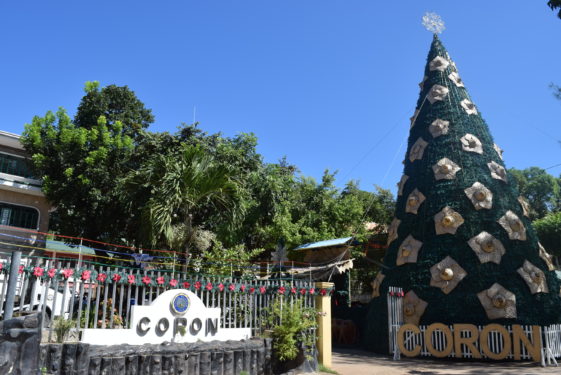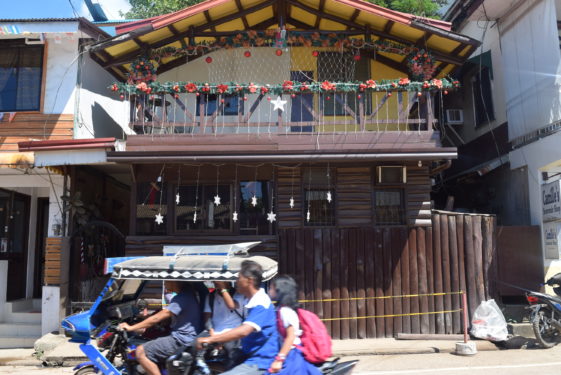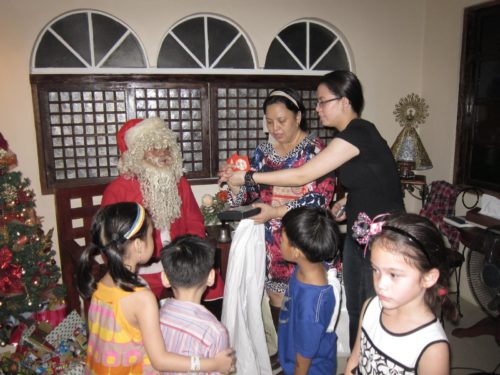
MANILA, Philippines – Christmas trees are up, festive lights are strung across street corners, shopping center speakers play classic Christmas carols and nativity sets depicting the starry night in Bethlehem scene are on display. The reason for the season: Jesus.
For the Philippines, the tradition to celebrate the light of Christ’s birth begins in September and unfolds with parishes also shedding light on the recurrent challenge of poverty and inequality.
The Haves and Have Nots
“Poverty is part of our lives here, although we have the privilege of not seeing or experiencing it,” says Stella Balgos, a parishioner at Presentation of the Child Jesus Church in the Diocese of Parañaque. “Some parishes like ours are well aware of our privilege and they make it a point to remind everyone in every homily that the point of our being Christian is giving back and sharing. So they make sure they have programs and causes that we can contribute to help.”
The Metro Manila resident said her parish is doing several programs including sponsoring “stars” for 500 pesos, or close to $10 USD, which then becomes a donation to a child who will receive Christmas gifts. Other programs her parish oversees include donating food baskets for poor families as well as hosting free Christmas parties for the less privileged – an event that is run completely by volunteers.
“I like that aspect about our parish because they’re aware of the social situation but are also doers and not just talkers,” Balgos added. “A lot of churches really double down efforts during the season. Schools too hold Christmas drives.”

Walking the Line of Poverty
For a country with a population of 106 million according to 2017 numbers by the United Nations, the proportion of households living below the official poverty line has declined slowly and unevenly in the past four decades.
That’s according to data by the Asian Development Bank, a financial institution headquartered in Manila. The bank also stated that poverty reduction in the Philippines pans much slower than neighboring Asian countries such as China, Indonesia, Thailand and Vietnam – a reality Balgos sees everyday.
“You can’t live here and have a privileged life and not be reminded of it,” she said. “You have to truly be deaf or blind to not empathize with the poor.”
Nonetheless, the Christmas spirit – and whether the focus is simply surface level or deeper and seen through eyes of mercy – it still holds its place as ‘the Main Holiday’ that begins the moment the calendar month ends with the three letters b-e-r as the unspoken rule.
Simbang Gabi and Noche Buena
For Filipinos, the nostalgic feeling the season provides might remind the country of the concept of togetherness. Whether it’s the formal Christmas celebrations like Simbang Gabi, when many people go to pre-dawn or early morning Masses during the nine days leading up to Christmas, or Noche Buena, a midnight feast on Christmas Eve that is an open house celebration with family, friends and neighbors as a means of wishing good tidings to all, the season begins to cap off when celebrating the first Sunday in January with the Epiphany, or the feast of Three Kings.
The word celebration and food are one and the same for Filipinos. Most households have several traditional dishes laid out that normally include lechon (a whole pig roasted from snout to tail), ham, lumpia egg rolls, fruit salad, rice cakes like puto bumbong, and other sweets and drinks.
Eighty percent of the country is Catholic and therefore holidays like Halloween aren’t as popular as say, the feasts of All Saints and All Souls. Most administrative offices are closed during liturgical days of obligation, like the Dec. 8 feast of the Immaculate Conception, because churches and streets are crowded with the faithful as seen at the Quiapo Church, the prominent basilica in Manila known for its Black Nazarene.
“It is the end of Ordinary Time and the homily tells us to love your neighbor and give charity to the poor so you will be in heaven,” said Emerita LaChica, a parishioner of Holy Eucharist Church in the Diocese of Parañaque.
LaChica attended a 5 a.m. eucharistic procession to celebrate the feast of Christ the King. It started on her parish grounds and continued through the neighborhood. She offered her time to decorate the altar for Christmas Day with rows of festive flowers she purchased herself.
“The people among the street were peaceful and I saw different organizations and I met a lot of people because faith is important to them.”
But as overpopulated as Manila is, poverty remains a mainly rural phenomenon and the poor tend to be agricultural workers, like farmers and fishers. For urban areas like Metro Manila, they are found in slums and are consist of large families with six or more members.
Throughout the urban sprawl, walls of aluminum, cardboard or bamboo are used to build a “home” that is squished underneath highways or next to polluted, dark grey rivers, – an invaluable resource for washing clothes and even bathing.

Christ Comes to Every ‘Home’
Whether passing through a slum, gated neighborhood or somewhere in between, sprinkled throughout are the colors of Christmas – red, green and white – a reminder of the long, festive holiday. Parols, or bamboo poles with a lighted star lantern wrapped in colored cellophane, are a popular decoration. That’s because the traditional Christmas stars represent the North Star – the iconic sign that guided the three wise men to the manger of Jesus’ birth.
One street sign, displayed among rows of makeshift shacks that are setup more for survival rather than square footage, might have summarized the Philippine spirit in one sentence: “Service to God, country and community is a way of life.”
“As it gets nearer and nearer to Christmas, all the displays will be out and everything will be decked,” said Balgos. “Even if you don’t have a lot of money, you can just sit somewhere and enjoy it.”
As the Philippines and the majority of its population put their faith on full display for another few weeks, the takeaway from this extended celebration could be two-fold: One is to shed a light of hope for those who have and those who have not.
And for those who do have, it’s an even longer time to reflect on how they might better serve God, country and an all-too-often-forgotten community in their midst.










Thank you for sharing this